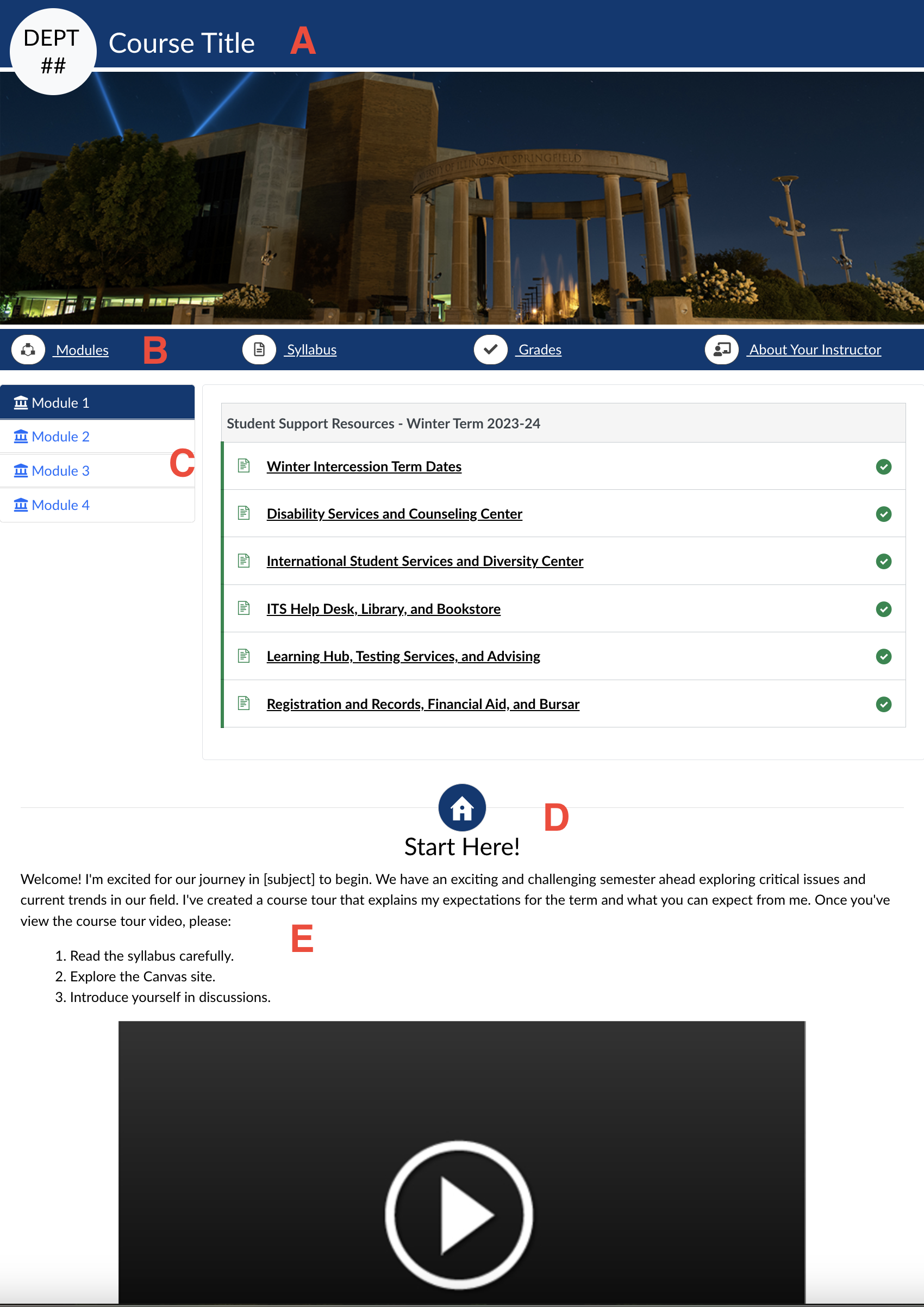For students in online courses, Canvas course sites are their experience of our university. An organized and consistent layout that specifically directs student attention scaffolds success. A carefully designed course homepage is a great first step in guiding your students through the materials and experiences you've designed in your course.
Course Design Elements for Homepages
In Canvas, you are able to choose where you want your students to start when they first click into the course. Your Canvas home page is the first impression a student has of your course. When strategically designed, home pages can guide students to the most effective actions that encourage learning and success in your course.
- A. Visually identify your course to help students confirm that they are in the right location. Creating distinctive home pages for each section can also support instructors who teach multiple sections of the same course.
- B. Improve navigation and usability. If students new to Canvas collapse the course menu by clicking on the hamburger button, they sometimes think that they have lost access to your course. By providing links to the most important Canvas areas, students are never “stuck.”
- C. Using tabs or buttons to reduce scrolling and distractions. The sample home page below shows links to each module in the course with an option display of the content for the current module. Buttons or links that take students to the module for the week is another great option to help focus student attention on the current topic.
- D. Guide your students by telling them where to begin. A start here section with an optional course video tour can help you to set expectations quickly.
- E. Set the tone for your communication and interaction style. A message on the home page can convey your teaching style and start building a learning community right away.
BONUS! The Canvas Student App displays home pages beautifully. Most of our students regularly access Canvas through a mobile device.

Student retention
Hammond and Shoemaker(link is external) (2014) found that “[m]any sources report higher dropout rates for online courses and programs as compared to traditional campus based courses and programs.” Shaikh and Asif(link is external) (2022) examined reasons why students might not persist through their online higher education programs and categorized those factors into:
- Demographic attributes
- Academic experience
- Relevant technical and management skills
- Behavioral and psychological attributes
- Personal variables
As instructors, it is impossible to focus on every possible factor that could contribute to a student’s decision to drop a course. However, by focusing on improving their academic experience through course design, we can mitigate the effects of other factors to help students persist through their education.
By implementing something as simple as a homepage into your Canvas course, you can immediately grab the attention of your students and improve their learning experience. If a homepage is learner-centered and intuitive, students will be able to navigate easily through the important parts of the course. Shaikh and Asif write that “[b]ad course organization, or at worst, lack of course organization and disconnected, illogical structures of the courses are linked with dropout decisions” and that “poor course design/organization affects learner satisfaction.” Providing clear places for students to begin their online learning experience or narrowing down their focus to specific modules on the homepage eliminates these issues.
One of the greatest ways in which course design can combat these negative outcomes is by instilling feelings of self-efficacy–or a “belief that one is capable of executing certain behaviors or achieving certain goals”–in students (Ormrod, 2011). Students need to feel that they can successfully and confidently move through their online courses without feeling overwhelmed or missing important information. If students feel they cannot even do that–which feels like a “basic” skill–then they are also more likely to believe that they cannot succeed when engaging with higher order tasks or complex content. A homepage is a simple way to empower online students.
This is especially true for first-generation college students. While all students benefit from these small design changes in an online course, “a significant interaction effect was found between the use of Design Tools [to create things like homepages] and students’ first generation status,” according to a report from The Center for Student Analytics at Utah State University (2019). The report goes on to say that “[t]his means that first-generation students achieved higher grades in courses taught by instructors who used Design Tools.” Reaching, retaining, supporting, and empowering this demographic of students is crucial and can be done, in part, by taking the time to welcome them into our online classes with well-designed course homepages.
Improved relationships
Social presence is important, especially in an online classroom. Wei, Chen, and Kinshuk(link is external) (2012) write that a “lack of social presence may lead to a high degree of frustration, an unreasonably critical attitude toward the instructor’s effectiveness, and a lower level of affective learning.” Student success in an online environment is dependent upon the connections they are able to make, especially with their instructors. There are many strategies that can positively contribute to instructor social presence, and among those strategies are course homepages. While these pages serve as a clear starting place for students entering an online course, they also serve as an opportunity for instructors to showcase themselves and the unique aspects of their course right away. “Humanizing” yourself immediately sets the tone for your course and how students will engage with it.
Intuitive and engaging course design also leads to greater satisfaction in a course, as well as higher student outcomes. According to Joosten and Cusatis(link is external) (2019), “Design and organization positively and significantly influenced students’ perceptions of learning and satisfaction as indicated in the analysis of the individual constructs of instructional characteristics.” Students who are engaged in a course that not only makes use of well-organized content but also aesthetically pleasing and intuitive navigation are more likely to feel that they are capable of greater learning and are more satisfied with their courses. They are likely to leave the course with positive feelings about their instructors as well as their online course and/or program. Joosten and Cusatis continue by asserting that “a strong effort should be made to design online courses,” especially in ways that are different from face-to-face courses.
Course Design Resources
- Rice University Workload Estimator - estimate the length of time coursework will take students
- A Self-Directed Guide to Designing Courses for Significant Learning by L.D. Fink (2005)
- The Impact of Design and Aesthetics on Usability, Credibility, and Learning in an Online Environment by Alicia David and Peyton Glore in Online Journal of Distance Learning Administration Volume 13, Issue 4 (2010)
- COLRS Resources on Canvas Commons
This page includes screen captures of home pages we’ve designed with Design Plus and shared through Canvas Commons for easy customization by UIS faculty and staff. - What is Canvas Commons?
Canvas Commons is a place where UIS instructors can share Canvas materials with one another. COLRS has developed a number of Canvas Commons resources for UIS faculty and staff to import into their Canvas courses. You can also choose to publish materials from your course(s) to Canvas and share them with other UIS instructors. - How do I set a home page in a Canvas course?
- Student Insights Report. (1) from the Center for Student Analytics at Utah State University (Fall 2019)
- Are There Differences in Academic and Social Integration of College of Agriculture Master's Students in Campus Based, Online and Mixed Programs? by D.E. Hammond and C. Shoemaker. NACTA Journal, 58(3), 180-188. (2014)
- A cross-institutional study of instructional characteristics and student outcomes: Are quality indicators of online courses able to predict student success? by T. Joosten and R. Cusatis. Online Learning, 23(4), 354-378. (2019)
- Social cognitive views of learning. by J.E. Ormrod. In Educational Psychology: Developing Learners (pp. 352-354). Prentice Hall PTR. (2011)
- Persistence and Dropout in Higher Online Education: Review and Categorization of Factors. by U.U. Shaikh and Z. Asif. Frontiers in Psychology, 13, 1-14. (May 31, 2022)
- A model for social presence in online classrooms. by C-W Wei, N-S. Chen, and Kinshuk. Education Tech Research Dev, 60, 529-545. (February 21, 2012)
